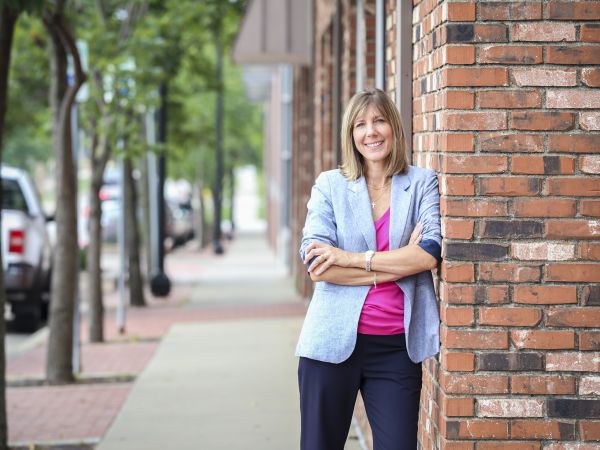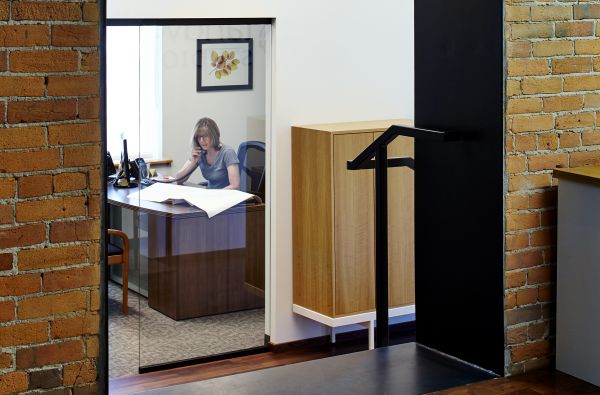that matter to you
A Conversation with Carisa: How She Got Her Start, Women in Landscape Architecture and Starting a Business
Category: News and Updates
Date: June 12, 2019
We sat down with Carisa McMullen, founder of Landworks Studio and asked her everything from the unusual way she started her career to how the profession has changed for women.
After graduating college, you took a non-traditional job. Tell me a little about that position, as well as what you learned.
In 1993, when I graduated, the country was in a recession. Jobs were more challenging to land for new graduates, and I was looking for opportunities to continue my professional development outside of a private practice design studio. I knew I was going to be in the Wichita area, and the late Frank Smith was referred to me as someone I should have a conversation with to discuss my next steps. Frank was a retired private practice professional and the founder of Oblinger Smith. He was finishing his career as the Director of Parks and Recreation for Wichita. His passion for land acquisition for public benefit had him at odds with many within the city organization. I respected and loved his fight and renegade approach.
I later learned Frank hired me without a position open. He knew the park landscape architect was slated to retire within a couple of years and time spent in the department would yield me enough experience to move into the position.
The reality was that my first job was an hourly position, federally funded through an arts program, to supervise at-risk kids cleaning outdoor sculpture within the city’s inventory. When I showed up to work, on my first sunny day in June, no one was at the community center where I was to meet a supervisor and the kids I would spend the summer getting to know. I was scrambling to call Frank to tell him I must have misunderstood the instructions and was concerned I was not starting off on the right foot – all without cell phones. What I found out was that the program fell through, and I wasn’t notified. Frank kindly said, “Come down to City Hall,” and that was the beginning of my career.
Frank assigned me to the recreation director, who later became the arts director for the city. At that time, the 1 Percent for Art Program was just starting to be discussed. There was much work to be done, including developing an inventory of existing art in the city’s collection, soliciting and qualifying artists for potential projects, developing and working with a design council that would oversee the potential for art on public infrastructure projects and writing RFQ’s to include art consultants and artists for a variety of projects.
At the time, I had no idea how influential this experience would be to my own practice and the municipal clients I would later serve.
How has your work with the Wichita Public Arts Program impacted your design style?
Understanding the difference between the role of an art consultant and collaborating with an artist has been very valuable as we approach each project and client with art included in the project. Landscape architects are creative professionals and have a tendency to want to control all aspects of each design. However, seeing the value of an artist’s perspective early on in my career proved to me that collaboration is key to #elevatingspaces.
You’ve cultivated a passion for integrated art over the course of your career. Why do you think it’s important?
There is a time and place for what I call “plunk art.” This is the easiest way to add art to a project. I, however, prefer the challenge of integrating art into projects, so the lines between aesthetics and function are blurred. My sales pitch is that if you are going to budget for any infrastructure improvement project, think about the impact of aesthetics early in the budgeting process. Artistic components can be considered within the design and can add significant value to the public. For example, if a bridge is included in a community’s capital improvement program for replacement, an art component or aesthetic elements can be integrated into the budget for relatively little cost. “If you are going to do something, do it beautifully.” This applies to any new or renovation project within a community.
Why did you start Landworks Studio?
At the time in Wichita, where I first started Landworks Studio, there weren’t any promoted landscape architecture firms. Landscape architects primarily practiced within architecture or engineering firms or were sole-proprietors. It was important to me to create a firm that focused exclusively on landscape architecture and was accessible and responsive. I wanted direct access to the clients to hear first-hand what their goals for their projects were, as well as control over the types of projects I was doing. I also hoped to demonstrate the capabilities and value of landscape architects. Starting my own firm was a way to accomplish all these things.
As a WBE, what advice would you give to women starting their own businesses?
I would start by saying do your research. Understand your place in the market and how you will contribute. I’d also say use mentors. Don’t assume you have to know it all. Last, but not least, I’d tell them to never stop learning. I’m constantly attending meetings, educational sessions, conferring with colleagues and reading articles to grow as a landscape architect and business owner. I encourage our team to do the same to spark inspiration and elevate our designs.
The landscape architecture field has more women in it now than it did when you entered the profession. How do you think we can encourage leadership among women?
I am in the process of learning more about women in the field of landscape architecture. Women entering the profession today seem to have a different perspective than those who graduated when I did. There were so few of us graduating in the early 1990’s that, at least for me, there was a level of insecurity and questioning about my place in the field. I burned myself out in college fighting to prove myself and didn’t want to start my career in that position. It was the reason I pursued work in the public sector versus private practice. As I talk to women around my age, we agree that we had no reason to feel the way we did. While we may approach design problems and work processes differently than our male counterparts, I have seen how offices with multiple perspectives have an advantage.
For the younger professionals, I am encouraging them to find their strengths and areas of contribution and capitalize on them in the workplace.
If you could go back and give yourself advice following college graduation, what would it be?
I would tell myself it is ok to choose my own path, and it is not expected that I have all the answers or know everything. Our profession is very diverse, and we each excel in our own ways and with our own passions.
What are some of your goals for the next 5 years? How do you see the firm evolving?
I see our studio growing with younger leadership stepping into key roles, guided by wisdom gained from experience and institutional knowledge. I am encouraged and energized by the creative and collaborative process, so I see our studio continuing to work to most successfully integrate the diversity within all the design professions to best meet our clients’ goals and expectations.
Specifically, a goal I have for the more immediate future is to seek out and respond to women who have entered or want to re-enter the profession and provide support and encouragement for their professional and personal benefits and the benefit of the profession.

